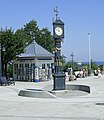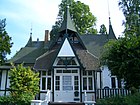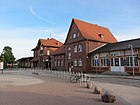Ahlbeck (Heringsdorf)
|
Ahlbeck
Municipality Heringsdorf
|
||
|---|---|---|
| Coordinates: 53 ° 56 ′ 28 " N , 14 ° 11 ′ 20" E | ||
| Residents : | 3395 (Dec. 31, 2003) | |
| Incorporation : | January 1, 2005 | |
| Incorporated into: | Three emperor baths | |
| Postal code : | 17419 | |
| Area code : | 038378 | |
|
Location of Ahlbeck in Mecklenburg-Western Pomerania |
||
|
Ahlbeck beach and promenade (2010)
|
||
The Seeheilbad Ahlbeck is part of the municipality of Ostseebad Heringsdorf and is the easternmost of the three imperial baths on the island of Usedom in the district of Vorpommern-Greifswald , Mecklenburg-Western Pomerania . Ahlbeck is right on the border with the Polish seaside resort of Swinoujscie .
In 2005 the three previously independent Baltic seaside resorts Ahlbeck, Heringsdorf and Bansin were merged to form the Dreikaiserbäder municipality . The municipality has been called Heringsdorf since 2006, but the seat of the municipal administration is in Ahlbeck ( municipality of Ostseebad Heringsdorf, Seebad Ahlbeck, Kurparkstraße 4 ).
Ahlbeck is connected to these seaside resorts and Swinoujscie, which has been Polish since the late 1940s, through the longest beach promenade in Europe, which stretches over 12 km across the four seaside resorts. The fine sandy beach from Świnoujście via Ahlbeck and Heringsdorf to Bansin stretches, on average 40 m wide, with a total of 42 km length in the further course to Peenemünde .
Ahlbeck is also connected to the Baltic Sea Cycle Route , which runs around the entire Baltic Sea within the European EuroVelo network.
history

Surname
Ahlbeck was first mentioned as Ahlebeck in 1693. The place derives its name from the Aal-Beeke (Aalbach, today Beek ), which connected the Gothensee and the Thurbruch through the later silted up Parchensee with the Baltic Sea . There was an eel crate near the mouth , which is included with the creek in the Lubin map from 1612.
Ahlbeck from 1700 to 1989
Around 1700 the owner of the Mellenthin and Gothen estates , Carl Leonhard Müller von der Lühne , had a water mill built on the Aal-Beeke , which served as a grain and cutting mill. He leased it to Michael Agner, a miller from the Stargarder Heide. At the same time, a fisherman and a tar burner settled down. The damming of the mills led to a constantly high water level in the Thurbruch, which had an unfavorable effect on the pastures in the neighboring villages such as Korswandt , as the meadows were often flooded. Franz Balthasar Schönberg von Brenkenhoff , commissioned by the Prussian King Friedrich II. With the improvement of the Thurbruch , therefore bought the mill in 1772 and had it removed. The owner at the time, War Councilor Peter Ernst von Meyenn , received 3700 thalers for this.
Brenckenhoff soon had twelve colonists settle there. Of these, four were fishermen who did beach fishing and had to keep the Beek watercourse clear. Together with the other eight Büdner posts , they formed the village of Ahlbeck as a royal share . On the Gothen side north of the Beek was Ahlbeck's aristocratic share , which consisted of four fishermen's houses in 1733 and five in 1779.
After the owner of Adelig Ahlbeck , Georg Bernhard von Bülow , had stopped selling land after 1820, he allowed it again from 1848. Around the middle of the 19th century, the two districts grew rapidly due to influx. In 1862 the aristocratic part had 370 inhabitants, the royal part 275. In 1870 the two districts together had around 800 inhabitants.
In the middle of the 19th century Johann Koch came to Ahlbeck as a teacher and cantor. In 1852 he accepted the first paying vacationers in his house. He founded a choir as well as the committee for the construction of a Protestant church , which organized collections for the construction of a church of its own. He did not live to see the laying of the foundation stone of the Ahlbeck Church in July 1894; Koch had died a few weeks earlier. In 1908 the community, which had grown in the meantime, was given the name Seebad Ahlbeck.
Ahlbeck since 1990
After the political change , the town center was thoroughly renovated from 1991 onwards as part of urban development funding.
On January 1, 2005, the three seaside resorts Ahlbeck, Heringsdorf and Bansin , which were previously independent municipalities, merged to form the municipality of Dreikaiserbäder . Since January 1, 2006, the larger community has been called Heringsdorf.
As an independent municipality, Ahlbeck had 3395 inhabitants on December 31, 2003.
politics
coat of arms
|
Blazon : “Split at an angle; above, in silver, a red griffin reinforced with gold, whose left muzzle and right paw are hidden by the lower field; below in blue an upwardly winding, left-turning silver eel. "
The coat of arms was designed by Hildegard Scholz from Ahlbeck . It was approved by the Prussian State Ministry on November 9, 1929 and registered under number 114 of the coat of arms of Mecklenburg-Western Pomerania. |
|
|
Reasons for the coat of arms: The coat of arms combines the heraldic animal of the Prussian province of Pomerania, the red griffin , with an animal motif, the eel. The latter establishes the visual reference to the place name. At the same time, the eel is intended to symbolize fishing as a traditional source of income for the inhabitants. The tinging indicates that the former municipality belonged to the former province of Pomerania.
As a result of the merger of the three Baltic seaside resorts, Ahlbeck's coat of arms lost its status as a national emblem on January 1, 2005. |
flag
The flag was designed by Sigrid Ulbrich from Ahlbeck and approved by the Ministry of the Interior on December 22, 1997.
“The flag is made of white cloth. It is covered in the first fifth below the upper edge and in the first fifth above the lower edge with a continuous blue twin wavy strip and in the middle with the coat of arms of the former municipality of Ostseeheilbad Ahlbeck. Each of the four wavy strips takes up one thirtieth, the coat of arms half the height of the flag. The height of the flag is related to the length as 3: 5. "
Attractions
Beach and promenade
Pier

The historic Ahlbeck pier was built in 1899 with a pier 280 m into the sea in Wilhelminian style and renovated in 1993. As the only one of the numerous piers on the Baltic Sea coast, Ahlbeck's pier was able to retain its historical structure, even if the wooden pile foundation had to be replaced by a steel pile foundation in 1971–1972.
On the square in front of the pier there is an Art Nouveau clock with playful garland ornamentation, which a spa guest donated to the community in 1911. The concert square with the open-air stage built in 1908 is in the immediate vicinity. In the summer season there are regular spa concerts and events here.
The beach at Ahlbeck is not only frequented during the bathing season. Ice bathing has been a tradition in the pier area since 1995. On Valentine's Day is every year for an event with more than 200 active floats and more than 1,000 spectators.
Resort architecture
Ahlbeck owns buildings in the style of classicistic spa architecture that are particularly worth seeing along the Dünenstraße, which runs parallel to the beach promenade : White dominates as the basic color in this street (example: No. 47), but is loosened up by colorful compositions in beige, bordeaux red and blue (example: No. 39 ), often typical with large rectangular windows, projecting central projections , triangular or segmented gables, turrets. Between 1991 and 2015, the town center and its spa architecture were extensively renovated with the help of urban development funding.
The Hotel Ahlbecker Hof had a number of prominent guests. Among them were the Austrian Emperor Franz Joseph I in 1905 , Louise Ebert in 1925 and the former Chancellor Gustav Bauer , Theo Lingen in 1939 , Queen Silvia of Sweden in 2006 and Federal President Horst Köhler and Queen Margrethe II of Denmark in 2008 .
OstseeTherme
The OstseeTherme swimming pool is a popular destination for tourists . In addition to the OstseeTherme, there has been a viewing tower with three steel platforms since 1996 , which can be reached either by stairs or an elevator. This tower also carries some antennas for cellular communications on a fourth small platform between the top platform and the top of the tower.
Historical monument
In a park on Lindenstrasse, a memorial has been commemorating the victims of fascism since 1954 , including 15 citizens of Ahlbeck. Also on Lindenstrasse at the train station is a Soviet cemetery of honor with a memorial for 85 soldiers and officers who fell on Usedom.
Frontier and frontier market
The state border with Poland has been two kilometers east of Ahlbeck since 1945 . Before 1990, hermetically sealed by a triple fence with a watchtower, after the fall of the Wall until December 20, 2007, the day when Poland also joined the Schengen Agreement, a border crossing reserved for pedestrians led from the mostly overcrowded car parking lot through approx Half a kilometer behind the border stretching "bazaar" to Swinoujscie (Świnoujście), the oldest seaside resort on the island. Today it is possible to cross the border at any point and by car (up to 3.5 t) via the border crossing at the eastern end of the former federal road 111 . Opened in 2011, the twelve-kilometer-long, continuous beach promenade connects the imperial baths of Bansin, Heringsdorf and Ahlbeck and the Polish port city of Swinoujście (Świnoujście).
Kaiser Wilhelm Children's Home
On the eastern edge of the village, just before the border to Poland, is the former Kaiser Wilhelm children's home, which now serves as the “Ahlbeck Youth Park” for the Berlin Sports Youth. A pavilion has been preserved alongside other buildings from the founding period. The complex was built in 1912 and 1913. The children's home was a foundation of Kaiser Wilhelm II. Schoolchildren and groups of children and young people were accommodated here. Later it was a recreation center for children whose parents were employed in large Berlin companies. After the end of the Second World War until 1949, the former children's home was the headquarters of the Soviet armed forces . Then it was the central pioneer camp " Boleslaw Bierut " until 1989 . Since 1993 it belongs to the Sportjugend Berlin, which belongs to the German Sportjugend .
Normal clock in front of the pier, a private donation from 1911.
Villa of the resort architecture in Ahlbeck
UBB train at Ahlbeck station on the Ducherow – Heringsdorf – Wolgaster ferry line .
sports clubs
The HSV Insel Usedom , based in Seebad Ahlbeck, is a handball club that was founded in April 2006 after the bankruptcy of HSV Blau Weiß Insel Usedom . The club's first team plays in the regional league. From 2004 to 2006 the team played in the second Bundesliga.
The SV Eintracht Ahlbeck 48 is a sports club with the divisions football, volleyball, bowling and women's gymnastics.
The TC Blau Weiss Ahlbeck is the local tennis club. The association founded in 1949 under the name BSG Aufbau Ahlbeck produced a number of GDR champions. Today six teams play in different divisions, including the 1st men's team in the Regionalliga Nord-Ost.
See also
Web links
Tourist information pages
- Ahlbeck on usedom.de (Usedom Tourismus GmbH)
- Official tourist information site of the 3 imperial baths Bansin, Heringsdorf and Ahlbeck (Usedom Tourismus GmbH)
Individual evidence
- ↑ Usedom's Europapromenade: Island opens cross-border, climate-neutral longest beach promenade in Europe , accessed on May 10, 2016.
- ↑ translator2: EuroVelo 10 - EuroVelo. Retrieved May 5, 2017 .
- ↑ Manfred Niemeyer: Ostvorpommern I . Collection of sources and literature on place names. Vol. 1: Usedom. (= Greifswald contributions to toponymy. Vol. 1), Ernst-Moritz-Arndt University of Greifswald, Institute for Slavic Studies, Greifswald 2001, ISBN 3-86006-149-6 , p. 5.
- ↑ a b Benno von Knobelsdorff-Brenkenhoff: The "Aal-Beek Colonists" and the Thurbruch on the island of Usedom in Western Pomerania. JG Herder Library Siegerland, Siegen 1992, pp. 15-19.
- ^ Wilhelm H. Pantenius, Claus Schönert: Between Haff and Heringsdorf. The Thurbruch on Usedom. Neuendorf Verlag, Neubrandenburg 1999, ISBN 3-931897-11-7 , pp. 28-29.
- ↑ Benno von Knobelsdorff-Brenkenhoff: The "Aal-Beek Colonists" and the Thurbruch on the island of Usedom in Western Pomerania. JG Herder-Bibliothek Siegerland, Siegen 1992, pp. 45–56.
- ↑ Benno von Knobelsdorff-Brenkenhoff: The "Aal-Beek Colonists" and the Thurbruch on the island of Usedom in Western Pomerania. JG Herder-Bibliothek Siegerland, Siegen 1992, pp. 52–53.
- ^ StBA: Changes in the municipalities of Germany - see 2005 , accessed on May 10, 2016.
- ↑ Hans-Heinz Schütt: On shield and flag production office TINUS, Schwerin 2011, ISBN 978-3-9814380-0-0 , p. 428
- ↑ Hans-Heinz Schütt: On shield and flag production office TINUS, Schwerin 2011, ISBN 978-3-9814380-0-0 , p. 428.
- ↑ Source for naming guests and their recovery times: memorial plaques on the facade.
- ↑ Lookout tower on the OstseeTherme Usedom website
- ^ SV Eintracht Seebad Ahlbeck 48 eV - The traditional club from the island of Usedom. Retrieved August 25, 2018 .



















